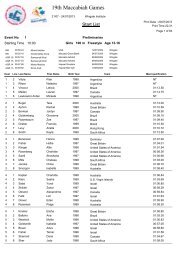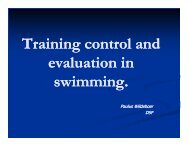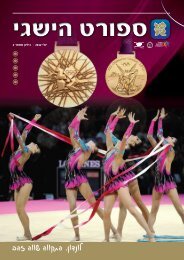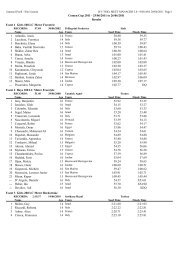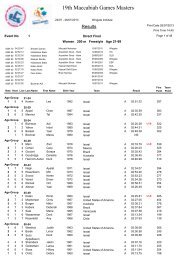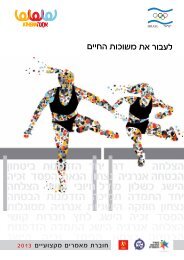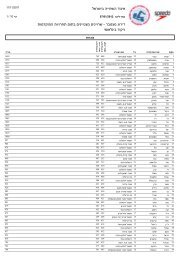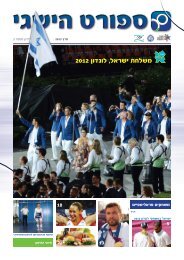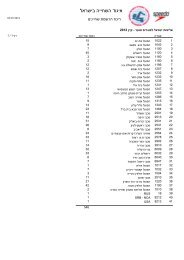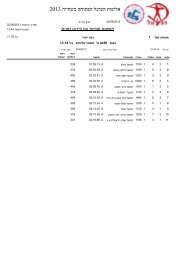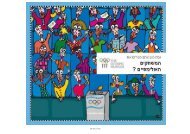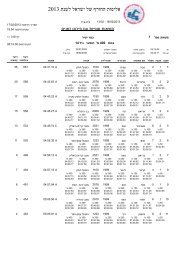You also want an ePaper? Increase the reach of your titles
YUMPU automatically turns print PDFs into web optimized ePapers that Google loves.
From learn to swim to the <strong>Olympic</strong>s.<br />
• Individual <strong>events</strong>:<br />
<strong>Olympic</strong> <strong>swimming</strong> <strong>events</strong>.<br />
• 50, 100, 200, 400, 800 (W), 1500 (M) and 10.000 Freestyle.<br />
• 100 and 200 Butterfly.<br />
• 100 and 200 Backstroke.<br />
• 100 and 200 Breaststroke.<br />
• 200 and 400 Medley.<br />
• Relay <strong>events</strong><br />
• 4 x 100 Freestyle<br />
• 4 x 200 Freestyle<br />
• 4 x 100 Medley<br />
Performance time in between 21 seconds (50 Freestyle) 2 hours minutes<br />
(10.000 Freestyle, “open” water <strong>swimming</strong>).<br />
Paulus Wildeboer DSU
From learn to swim to the <strong>Olympic</strong>s.<br />
Swimming > 50 to 800 1500 3000 6000 10.000<br />
Paulus Wildeboer DSF
From learn to swim to the <strong>Olympic</strong>s.<br />
The requirements for different event lengths.<br />
Paulus Wildeboer DSF
From learn to swim to the <strong>Olympic</strong>s.<br />
• What to do with all these different requirements + differences<br />
in age and gender?<br />
Possibilities to win a medal in the <strong>Olympic</strong> Games.<br />
50 free 100 free 200 free 400 free 800 free (W) 10.000 free<br />
100 fly 200 fly 400 medley 1500 free (M)<br />
100 back 200 back<br />
100 breast 200 breast<br />
4 x 100 free 200 medley<br />
4 x 100 medley 4 x 200 free<br />
3 18 18 6 + 6 + 3 = 15<br />
21<br />
52<br />
31<br />
Paulus Wildeboer DSF
From learn to swim to the <strong>Olympic</strong>s.<br />
Training philosophy.<br />
• Aerobic based development.<br />
• At the same time an “interesting” and motivating program.<br />
• Use other cyclic sports to develop the Aerobic Capacity like;<br />
Nordic ski, rowing, sky walk, biking, running, etc. During the<br />
general part of the preparation.<br />
• Dry land program in between 25 and 35 % total training<br />
time.<br />
• Healthy and injury free swimmers.<br />
• High demand on technical skills at all times.<br />
• Create a trainings program that helps the swimmers to<br />
experience POSITIVE REINFORCEMENT all year long.<br />
• (how to make ALWAYS the best of it video)<br />
• http://www.youtube.com/watch?v=X_XW6Y-<br />
K3QE&feature=related<br />
Paulus Wildeboer DSF
From learn to swim to the <strong>Olympic</strong>s.<br />
• Aerobic based training<br />
• Yearly Volume in between 2000 and 3000 km.<br />
• Average x week (46 weeks) = in between 44 and 65 km.<br />
• At an average of 3 km/hour gives us in between 15 and 22 hours of swim<br />
training x week.<br />
• Normally 10 training sessions a week = in between 1 ½ and 2 ½ hours x session.<br />
• I apply so called “high volume” weeks with triple workout days and max<br />
volume around 80 km x week (for the distance group).<br />
• A lot of Aerobic Capacity work is done in between the HIGH INTENSITY sets /<br />
workouts.<br />
• During the “TAPER” we only lower significant the volume with the so called<br />
“sprinters”, all the others lower the intensity and not so much the volume.<br />
Paulus Wildeboer DSF
From learn to swim to the <strong>Olympic</strong>s.<br />
Training philosophy.<br />
What do we need, to have success at World Championships and OG?<br />
• Talented motivated and “professional” swimmers and coaches.<br />
• A training program, at least as good as the BIGGER and leading countries , USA, AUS,<br />
GBR, JAP, RUS, CHN, HUN, GER, ….<br />
• “Super” competitors , especially in the second part (+ last part) of the race.<br />
• Swim FAST in the Heats, FASTER in the Semi final and FASTEST in the Final.<br />
• (link to results Rome 2009)<br />
• + recovery capacity, both during competition as well as to assure high quality during<br />
training en general + better and faster recovery during high intensity sets.. (aerobic<br />
based training)<br />
Paulus Wildeboer DSF
From learn to swim to the <strong>Olympic</strong>s.<br />
• How did we arrive at this extra ordinary high level in<br />
international <strong>swimming</strong>?<br />
• The 60 ‘ ties – start of training systems, interval training, talent is much more important than<br />
training.<br />
• The 70 ’ ties – the training volume is increasing, people start to do double training, some of<br />
them do triple.<br />
• The 80 ‘ ties – even more volume, (Sweetenham and Schubert) trying to beat each other with<br />
even more km. Where is the limit?<br />
• The 90 ‘ ties – Switching from volume to intensity, especial in Europe. Political revolution<br />
provoke s poor results for the communist countries. WR do not improve any more at the same<br />
rhythm.<br />
• Sydney 2000 - USA keeps up the level, Europe is drowning. Best ever <strong>Olympic</strong> Swimming Games.<br />
AUS and Asia leading……<br />
• 2005/7– Europe is fighting to get back. AUS y USA change with each other the leadership in<br />
Men and Women.<br />
• 2008 and 2011 - AUS and USA still leading far ahead, the rest of the world following in the<br />
shadow , many countries with individual super talented swimmers, many of them live and train<br />
abroad (USA). GBR, BRA and DEN are the countries who develop most (and fast). LINK TS LONDON<br />
Men + Women.<br />
Paulus Wildeboer DSF
From learn to swim to the <strong>Olympic</strong>s.<br />
Training philosophy.<br />
What does that mean for the preparation of my swimmers?<br />
• Prepare the 200 meter at world class level and compete also in the 100.<br />
• Prepare the 400 at world class level and compete also in the 200.<br />
• Prepare the 800 / 1500 at world class level and compete also the 400.<br />
• Prepare the 10.000 and help the team to think “big” in volume if necessary.<br />
• Maybe with some extremely motivated and talented swimmers, prepare the<br />
100 at world class level and compete in the 50.<br />
Paulus Wildeboer DSF
From learn to swim to the <strong>Olympic</strong>s.<br />
• Lost of velocity for “Sprinters” and “distance” swimmers,<br />
related to the event to swim.<br />
10<br />
9<br />
distance<br />
8<br />
7<br />
6<br />
5<br />
4<br />
3<br />
2<br />
1<br />
0<br />
sprinter<br />
50 100 200 400 800 1500 3000 6000 10000<br />
Paulus Wildeboer DSF
From learn to swim to the <strong>Olympic</strong>s.<br />
National Chinese Congress<br />
Wake up !!<br />
You might<br />
miss the<br />
interesting<br />
part…….<br />
Paulus Wildeboer DSF
From learn to swim to the <strong>Olympic</strong>s.<br />
• A practical example<br />
Paulus Wildeboer DSF
From learn to swim to the <strong>Olympic</strong>s.<br />
http://www.youtube.com/watch?v=ht7wTd5U9_w<br />
http://www.youtube.com/watch?v=6qw29AbLKP8
From learn to swim to the <strong>Olympic</strong>s.<br />
• Aerobic based training<br />
• Yearly Volume in between 2000 and 3000 km.<br />
• Average x week (46) = in between 44 and 65 km.<br />
• At an average of 3 km/hour gives us in between 15 and 22 hours of swim<br />
training x week.<br />
• Normally 10 training sessions a week = in between 1 ½ and 2.2 hours x<br />
session<br />
• We apply so called “high volume” weeks with triple workout days and max<br />
volume around 80 km x week (for the distance group).<br />
• A lot of Aerobic Capacity work is done in between the HIGH INTENSITY<br />
sets / workouts.<br />
• During the “TAPER” we only lower significant the volume with the so called<br />
“sprinters”, all the others lower the intensity and not so much the volume.<br />
Paulus Wildeboer DSF
• Training zones (link)<br />
• Volume, AT, lactate 3 and 6<br />
• Searching and trying to improve.<br />
•<br />
From learn to swim to the <strong>Olympic</strong>s.<br />
Paulus Wildeboer DSF.
14<br />
13<br />
12<br />
11<br />
10<br />
9<br />
8<br />
7<br />
6<br />
5<br />
4<br />
3<br />
2<br />
1<br />
0<br />
From learn to swim to the <strong>Olympic</strong>s.<br />
Step<br />
TEST<br />
test<br />
PROGRESIVO<br />
10 x 200 done<br />
( 8<br />
as<br />
X<br />
3<br />
100<br />
/ 2<br />
,<br />
/<br />
8<br />
2<br />
X<br />
/<br />
200<br />
1 / 1<br />
, 5<br />
/ 1.<br />
X 400 .)<br />
LACTATO M.MOL/L.<br />
�<br />
�<br />
ZONA 1<br />
�<br />
MODELO EJEMPLAR<br />
�<br />
�ZONA<br />
2<br />
�<br />
1,26 1,3 1,34 1,38 1,42 1,46 1,5 1,54 1,58 1,62 1,66 1,7 1,74<br />
VELOCIDAD M./SEC.<br />
�<br />
�<br />
ZONA 3<br />
PROGRESIO� E� ZO�A 1 MEJORAR TRABAJO AEL y AEM. //// ZO�A 2 MEJORAR TRABAJO AEI Y FUERZA RESISTE�CIA .<br />
//// ZO�A 3 MEJORAR TRABAJO A�LA Y FUERZA MAX.<br />
�<br />
� �<br />
TEST I�ICIAL<br />
META<br />
Paulus Wildeboer DSF
From learn to swim to the <strong>Olympic</strong>s.<br />
“Devil over the church”
14<br />
13<br />
12<br />
From learn to swim to the <strong>Olympic</strong>s.<br />
TEST PROGRESIVO ( 8 X 100 , 8 X 200 , 5 X 400 .)<br />
MODELO EJEMPLAR<br />
11 Women % off the goal example<br />
�<br />
% off the goal example<br />
10<br />
9<br />
8<br />
Desired Lactate / Velocity level to be achieved;<br />
Distance Step the test 200 10 metros, x 200 % done off the as goal 3 / time 2 / 2 (for / 1 example / 1 / 1. 2:00.0)<br />
LACTATO M.MOL/L.<br />
Lactate 3 m.mol Lactate 6 m.mol Lactate max.<br />
Distance 91% 2:11.8 95% 2:06.3 10 m.mol<br />
Middle distance 7<br />
90% 2:13.3<br />
ZONA 3<br />
94% 2:07.6 12 m.mol<br />
Sprint + 6Fly<br />
88% �2:16.3<br />
93% � 2:09.0 14 m.mol<br />
5<br />
4<br />
Men 3<br />
�ZONA<br />
2 �<br />
% �off<br />
the goal example � % off the goal example 2:00.0<br />
2<br />
Distance1 �<br />
ZONA 1 90%<br />
�<br />
2:13.3 94% �TEST I�ICIAL 2:07.6<br />
�META<br />
12 m.mol<br />
0<br />
Middle distance 88% 2:16.3 93% 2:09.0 15 m.mol<br />
1,26 1,3 1,34 1,38 1,42 1,46 1,5 1,54 1,58 1,62 1,66 1,7 1,74<br />
VELOCIDAD M./SEC.<br />
Sprint + Fly 85% 2:21.1 91% 2:11.8 17 m.mol<br />
PROGRESIO� E� ZO�A 1 MEJORAR TRABAJO AEL y AEM. //// ZO�A 2 MEJORAR TRABAJO AEI Y FUERZA RESISTE�CIA .<br />
//// ZO�A 3 MEJORAR TRABAJO A�LA Y FUERZA MAX.<br />
Paulus Wildeboer DSF
From learn to swim to the <strong>Olympic</strong>s.<br />
• Searching and trying to improve………….<br />
• Wolfgang Richter (DDR/GER)<br />
• Jan Oldbrecht (BEL)<br />
• Jacco Verhaeren (NED)<br />
• Olimpic Games Sidney 2000<br />
• Clive Rusthon (GBR)<br />
• Trial and error<br />
• Capacitiy and Power<br />
• Balance between AEC and ANC
From learn to swim to the <strong>Olympic</strong>s.<br />
lactate HR = bbm Capacity Power<br />
% Total<br />
Volume<br />
AE 0 (rec.) 5% - 10%<br />
Recovery<br />
hours<br />
AE 1 < 2 60 - 50 AEC 20% - 30% 6 – 12<br />
AE 2 2 50 - 40 AEC 20% - 30% 6 - 12<br />
AE 3 3 40 - 30 AEC 20% - 30% 6 - 12<br />
AT 3 - 5 30 - 20 AEP 2% - 4% 12 - 24<br />
LC 5 - 7 30 - 10 AEP Ind. 12 - 36<br />
VO2 MAX 6 - 10 20 - 10 AEP or ANP Ind. 18 - 48<br />
AN TOL 8 - 15 10 - max ANP 1% 36 - 72<br />
AN PROD MAX MAX ANC Ind. 36 - 72<br />
SPEED N.R. N.R. SP 2% - 3% 6 - 12<br />
Paulus Wildeboer DSF
Capacity and Power<br />
(model model = copy right<br />
Clive Rusthon / Swimformation)<br />
Swimformation<br />
• First develop the CAPACITIES<br />
AEC = Aerobic Capacity<br />
together with<br />
ANC = Anaerobic Capacity<br />
As basic components.<br />
• After improving the Capacities work<br />
on the POWER (= Race Pace or close to)<br />
AEP = Aerobic Power<br />
or / and<br />
ANP = Anaerobic Power<br />
As specific race pace work.<br />
Paulus Wildeboer DSF
10.000 – 6000 – 3000 – 2000<br />
From learn to swim to the <strong>Olympic</strong>s.<br />
1500 - 800 - 400 - 200 - 100 - 50<br />
AEC - AEP - ANP - ANC<br />
•<br />
Both for<br />
swimmers as well<br />
as for coaches<br />
STRENGHT – POWER – SPEED --TECHNIQUE<br />
Paulus Wildeboer DSF
10.000 – 6000 – 3000 – 2000<br />
From learn to swim to the <strong>Olympic</strong>s.<br />
1500 - 800 - 400 - 200 - 100 - 50<br />
AEC - AEP - ANP - ANC<br />
• Both for<br />
swimmers as well<br />
as for coaches<br />
STRENGHT – POWER – SPEED --TECHNIQUE<br />
Paulus Wildeboer DSF
AE 1
From learn to swim to the <strong>Olympic</strong>s.<br />
lactate HR = bbm Capacity Power Rec. hours<br />
AT 3 - 5 30 - 20 AEP 12 - 24<br />
AT = Anaerobic Threshold = mix between between AErobic and ANaerobic work.<br />
• Many years considered as a very important specific intensity point.<br />
• Some Scientifics consider(ed) it to be at 4 mmol/l. lactate.<br />
• Many coaches found out that it was most of the time closer to 3.<br />
• Now we know that it is very individual and it is not considered a “point” any more where<br />
Aerobic work changes in Anaerobic work.<br />
• There is not such a point, now we speak about progressive increasing of lactate production.<br />
• Explain what I did and what I do now, considering AT.<br />
• Be careful !! (practical example of a mix up between what we pretend the workout to be and<br />
what ambition and illusion can “disturb”.<br />
AT<br />
Paulus Wildeboer DSF
From learn to swim to the <strong>Olympic</strong>s.<br />
lactate HR = bbm Capacity Power Rec. hours<br />
LC 5 - 7 30 - 10 AEP 12 - 36<br />
LC = Lactate Clearance = Learn how to “use” the produced lactate in the energy production.<br />
•This is a “new” concept to be considered in our training.<br />
•You can learn to produce lactate and you can learn how to re-use the lactate.<br />
•The idea is to “teach” the body how to use the produced lactate within the metabolic energy<br />
production system. (energy_systems.pdf)<br />
•Some of the most talented swimmers (physiological talented) are able to do that extremely well. I<br />
think that this is the big difference between them, not the technique, the strength (endurance) or<br />
their trainings level.<br />
•Examples, Wolfgang, Silvia, Joaquim, Erika, Xavi, Lotte, Hacket, Manadou, Phelps and others.<br />
• (buffer capacity)<br />
•Very specific for the working cells and their neighbors.<br />
• Also improvement when Aerobic recovery work is done after high intensity work.
From learn to swim to the <strong>Olympic</strong>s.<br />
lactate HR = bbm Capacity Power Rec. hours<br />
LC 5 - 7 30 - 10 AEP 12 - 36<br />
LC = Lactate Clearance = Learn how to “use” the produced lactate in the energy production.<br />
•This is a “new” concept to be considered in our training.<br />
•You can learn to produce lactate and you can learn how to re-use the lactate.<br />
•The idea is to “teach” the body how to use the produced lactate within the metabolic energy<br />
production system. (energy_systems.pdf)<br />
•Some of the most talented swimmers (physiological talented) are able to do that extremely well. I<br />
think that this is the big difference between them, not the technique, the strength (endurance) or<br />
their trainings level.<br />
•Examples, Wolfgang, Silvia, Joaquim, Erika, Xavi, Lotte, Hacket, Manadou, Phelps and others.<br />
• (buffer capacity)<br />
•Very specific for the working cells and their neighbors.<br />
• Also improvement when Aerobic recovery work is done after high intensity work.
From learn to swim to the <strong>Olympic</strong>s.<br />
lactate HR = bbm Capacity Power Rec. hours<br />
VO2 MAX 6 - 10 20 - 10 AEP or ANP 18 - 48<br />
VO2 max = Maximum Oxygen uptake = The highest possible intensity for work in between 2<br />
and 20 minutes.<br />
• This is the intensity zone which many swimmers “use” to compete, especially in the 200, 400, 800<br />
and 1500 meter <strong>events</strong>.<br />
• Not so long ago we (I) thought that VO2 max was reached with lower lactate levels.<br />
• Swimmers need to have high energy levels to be able to perform in this zone during workout, both<br />
in their body as well as in their mind.<br />
• It is clearly the highest demanding work to do / be done.<br />
• You can also call this kind of work Race Pace, it all depends on the set you offer them.<br />
• Again this has to be done with specific work (stroke, FR, duration) because the muscle cell benefits<br />
most.<br />
• Needs a long recovery time and too many too often is the main reason for “over training”.<br />
Paulus Wildeboer DSF
From learn to swim to the <strong>Olympic</strong>s.<br />
lactate HR = bbm Capacity Power Rec. hours<br />
VO2 MAX 6 - 10 20 - 10 AEP or ANP 18 - 48<br />
VO2 max = Maximum Oxygen uptake = The highest possible intensity for work in between 2<br />
and 20 minutes.<br />
• This is the intensity zone which many swimmers “use” to compete, especially in the 200, 400, 800<br />
and 1500 meter <strong>events</strong>.<br />
• Not so long ago we (I) thought that VO2 max was reached with lower lactate levels.<br />
• Swimmers need to have high energy levels to be able to perform in this zone during workout, both<br />
in their body as well as in their mind.<br />
• It is clearly the highest demanding work to do / be done.<br />
• You can also call this kind of work Race Pace, it all depends on the set you offer them.<br />
• Again this has to be done with specific work (stroke, FR, duration) because the muscle cell benefits<br />
most.<br />
• Needs a long recovery time and too many too often is the main reason for “over training”.<br />
Paulus Wildeboer DSF
From learn to swim to the <strong>Olympic</strong>s.<br />
lactate HR = bbm Capacity Power Rec. hours<br />
AN TOL 8 - 15 10 - max ANP 36 - 72<br />
AN TOL = Anaerobic Tolerance = Keeping the highest possible speed for a period in<br />
between 40” and 90”.<br />
Very well known in swim training and probably used and abused.<br />
• It comes as close as possible to Race Speed, which is not (always) the same as Race Pace.<br />
• Also called “under” and “over” distance (100 m.) training.<br />
• This is clearly the training zone which has a very bad influence over the AEC.<br />
• I believe that it should be done mostly in Competition in so called Training Competitions.<br />
• Improvement;<br />
• buffer capacity,<br />
• Glycogen,<br />
• CP/ATP level in the muscle cells,<br />
• recovery from high lactate levels,<br />
• how to keep the right technique when lactate is close to max.<br />
• Should also be used to learn the swimmers to compete close to their PB at all times . Gennadi<br />
Touretski (Popov and many others), uses it with the so called “Cold swims”.<br />
• Gives us a great opportunity to “over stress” the AEC (and during a while the AEP) zones when<br />
we do the recovery work to get rid of the Lactate.<br />
Paulus Wildeboer DSF
From learn to swim to the <strong>Olympic</strong>s.<br />
lactate HR = bbm Capacity Power Rec. hours<br />
AN TOL 8 - 15 10 - max ANP 36 - 72<br />
AN TOL = Anaerobic Tolerance = Keeping the highest possible speed for a period in<br />
between 40” and 90”.<br />
Very well known Gives in swim training us a and great probably used opportunity and abused. to<br />
• It comes as close as possible to Race Speed, which is not (always) the same as Race Pace.<br />
• Also called “under” and “over” distance (100 m.) training.<br />
“over stress” the AEC (and during<br />
• This is clearly the training zone which has a very bad influence over the AEC.<br />
• I believe that it should be done mostly in Competition in so called Training Competitions.<br />
• Improvement; a while the AEP) zones when we<br />
do the recovery work to get rid<br />
of the Lactate.<br />
• buffer capacity,<br />
• Glycogen,<br />
• CP/ATP level in the muscle cells,<br />
• recovery from high lactate levels,<br />
• how to keep the right technique when lactate is close to max.<br />
• Should also be used to learn the swimmers to compete close to their PB at all times . Gennadi<br />
Touretski (Popov and many others), uses it with the so called “Cold swims”.<br />
• Gives us a great opportunity to “over stress” the AEC (and during a while the AEP) zones when<br />
we do the recovery work to get rid of the Lactate.<br />
Paulus Wildeboer DSF
From learn to swim to the <strong>Olympic</strong>s.<br />
lactate HR = bbm Capacity Power Rec. hours<br />
AN TOL 8 - 15 10 - max ANP 36 - 72<br />
AN TOL = Anaerobic Tolerance = Keeping the highest possible speed for a period in<br />
between 40” and 90”.<br />
Very well known Gives in swim training us a and great probably used opportunity and abused. to<br />
• It comes as close as possible to Race Speed, which is not (always) the same as Race Pace.<br />
• Also called “under” and “over” distance (100 m.) training.<br />
“over stress” the AEC (and during<br />
• This is clearly the training zone which has a very bad influence over the AEC.<br />
• I believe that it should be done mostly in Competition in so called Training Competitions.<br />
• Improvement; a while the AEP) zones when we<br />
do the recovery work to get rid<br />
of the Lactate.<br />
• buffer capacity,<br />
• Glycogen,<br />
• CP/ATP level in the muscle cells,<br />
• recovery from high lactate levels,<br />
• how to keep the right technique when lactate is close to max.<br />
• Should also be used to learn the swimmers to compete close to their PB at all times . Gennadi<br />
Touretski (Popov and many others), uses it with the so called “Cold swims”.<br />
• Gives us a great opportunity to “over stress” the AEC (and during a while the AEP) zones when<br />
we do the recovery work to get rid of the Lactate.<br />
Paulus Wildeboer DSF
From learn to swim to the <strong>Olympic</strong>s.<br />
lactate HR = bbm Capacity Power Rec. hours<br />
AN PROD MAX MAX ANC 36 - 72<br />
AN PRO = Anaerobic production = the capacity to produce as much energy as possible in<br />
a period of time in between 15” and 40”.<br />
• The aim is to learn to produce as much (Anaerobic) energy as possible in a very short period<br />
of time.<br />
• Distance should be short, in between 30 and 75 meters and the velocity should be max.<br />
• Can and should be done in all kind of variations including kicking.<br />
• Improvement<br />
• in the velocity of the Anaerobic metabolism.<br />
• level of CP / ATP in the used muscle cells.<br />
• “neuromuscular” coordination capacity from the muscles.<br />
• Most of the swimmers like this kind of training.<br />
• Should and can be done from the beginning of the season.<br />
• Now a days considered as basic as the AEC work.<br />
• Should be developed together with increasing the strength.<br />
• High FR and if possible DPS.<br />
•Complete recovery and volume depending on the level on which the set is done.<br />
Paulus Wildeboer DSF
From learn to swim to the <strong>Olympic</strong>s.<br />
lactate HR = bbm Capacity Power Rec. hours<br />
AN PROD MAX MAX ANC 36 - 72<br />
AN PRO = Anaerobic production = the capacity to produce as much energy as possible in<br />
a period of time in between 15” and 40”.<br />
• The aim is to learn to produce as much (Anaerobic) energy as possible in a very short period<br />
of time.<br />
• Distance should be short, in between 30 and 75 meters and the velocity should be max.<br />
• Can and should be done in all kind of variations including kicking.<br />
• Improvement<br />
• in the velocity of the Anaerobic metabolism.<br />
• level of CP / ATP in the used muscle cells.<br />
• “neuromuscular” coordination capacity from the muscles.<br />
• Most of the swimmers like this kind of training.<br />
• Should and can be done from the beginning of the season.<br />
• Now a days considered as basic as the AEC work.<br />
• Should be developed together with increasing the strength.<br />
• High FR and if possible DPS.<br />
•Complete recovery and volume depending on the level on which the set is done.<br />
Paulus Wildeboer DSF
From learn to swim to the <strong>Olympic</strong>s.<br />
SPEED N.R. N.R. 6 - 12<br />
Speed = Work at the highest Velocity , period of time in between 1” and 12”<br />
•Rest, Speed, every day/workout, S/T/F/RTO, games, warm, relaxed, etc.<br />
Paulus Wildeboer DSF
From learn to swim to the <strong>Olympic</strong>s.<br />
SPEED N.R. N.R. 6 - 12<br />
Speed = Work at the highest Velocity , period of time in between 1” and 12”<br />
•Rest, Speed, every day/workout, S/T/F/RTO, games, warm, relaxed, etc.<br />
Paulus Wildeboer DSF
From learn to swim to the <strong>Olympic</strong>s.<br />
SPEED N.R. N.R. 6 - 12<br />
Speed = Work at the highest Velocity , period of time in between 1” and 12”<br />
“The faster you (try)<br />
to swim the more<br />
relaxed it should be”<br />
(100% performance with 90% effort)<br />
•Rest, Speed, every day/workout, S/T/F/RTO, games, warm, relaxed, etc.<br />
Paulus Wildeboer DSF
From learn to swim to the <strong>Olympic</strong>s.<br />
Goal level for international TOP swimmer Aerobic Capacity (AEC).<br />
AEC – Senior 3000 freestyle Average x 100 Blood lactate<br />
Men 31.30 – 33.00 1.03 – 1.05 < 4<br />
Women 34.00 – 35.00 1.08 – 1.10 < 3<br />
National Team example AEC test results.<br />
• If you want to know what time an age grouper or junior should swim,<br />
look at the 1500 in the progresion curve and x 2 + 45”.<br />
Paulus Wildeboer DSF
From learn to swim to the <strong>Olympic</strong>s.<br />
• Goal level for international TOP swimmer Aerobic Power (AEP).<br />
AEP - Senior 2000 IM Average x 200 Blood lactate<br />
Men 24.35 – 25.00 2.25 – 2.30 4 - 6<br />
Women 26.40 – 27.05 2.40 – 2.45 3 - 5<br />
“Normaly changing the stroke @ 50, but distance swimmers and 400 IM’ers<br />
can also change, for example, (800 @ 200) + (800 @ 100) + (400 @ 50)<br />
Paulus Wildeboer DSF
From learn to swim to the <strong>Olympic</strong>s.<br />
• Goal level for international TOP swimmer Anaerobic Capacity (ANC)<br />
ANC - Senior 4 x 50 @3 min. Average x 50 Blood lactate<br />
Men Fly 24.0 max<br />
Back 25.5 max<br />
Breast 28.8 max<br />
Free 22.8 max<br />
Women Fly 27.0 max<br />
Back 29.4 max<br />
Breast 32.0 max<br />
Free 26.0 max<br />
Paulus Wildeboer DSF
From learn to swim to the <strong>Olympic</strong>s.<br />
• Goal level for an international TOP swimmer SPEED (SP).<br />
SPEED- Senior 1 x 25 Time Blood lactate<br />
Men Fly 10.5 nr<br />
Back 10.9 nr<br />
Breast 11.9 nr<br />
Free 9.8 nr<br />
BOYB (15 m.) 5.4 nr<br />
Women Fly 11.7 nr<br />
Back 12.8 nr<br />
Breast 13.7 nr<br />
Free 11.2 nr<br />
BOYB (15 m.) 6.3 nr
From learn to swim to the <strong>Olympic</strong>s.<br />
Season Planning<br />
Paulus Wildeboer DSF
From learn to swim to the <strong>Olympic</strong>s.<br />
ONE cycle x year for promising very young age group swimmers<br />
<strong>One</strong> cycle year plan in order to develop the best possible technique.<br />
Dry land => learn to control your body<br />
Feel the water => gliding, sculling, playing all kind of games in the (un deep) water.<br />
Learn to kick => to learn to swim the competition strokes you need a very good kick.<br />
Learn different parts of the complete stroke => “drills”.<br />
Put everything together => swim short distances with a “perfect” technique.<br />
Paulus Wildeboer DSF
From learn to swim to the <strong>Olympic</strong>s.<br />
TWO cycles x year for age group swimmers ( 23 / 24 weeks each).<br />
1st cycle => for age group swimmers (25 m. pool)<br />
Dry land and technique (like the one year cycle).<br />
Develop the AEC and ANC in all 5 strokes.<br />
Develop the AEP / ANP with VO2max sets.<br />
Compete in 25 meter pool and swim a lot of PB´s.<br />
Rest for 1 or 2 weeks. (summer 2 or 3 weeks)<br />
2nd cycle => for age group swimmers (50 m. pool)<br />
Dry land and technique (like the one year cycle).<br />
Develop the AEC and ANC in all 5 strokes.<br />
Develop the AEP / ANP with VO2max sets.<br />
Compete in 50 meter pool and repeat or improve the 25 m. times<br />
Rest for 1 or 2 weeks. (summer 2 or 3 weeks)<br />
Paulus Wildeboer DSF
1st cycle => (25 m. pool)<br />
From learn to swim to the <strong>Olympic</strong>s.<br />
THREE cycles x year for junior and senior swimmers /15 / 16 weeks each).<br />
Dry land and technique (like the two year cycle).<br />
Develop the AEC and ANC as general as possible.<br />
Develop the AEC and ANC more specific.<br />
Develop the AEP / ANP according to the individual qualities and needs.<br />
Do a complete taper in order to “learn” about each swimmer.<br />
Compete in 25 meter pool and swim a lot of PB´s.<br />
Rest for 1 week. (summer 2 or 3 weeks)<br />
3 x<br />
• 2 cycle => 50 m. pool and qualify for the summer.<br />
• 3 cycle => 50 m. pool and obtain the best performance from the whole season.<br />
Paulus Wildeboer DSF
From learn to swim to the <strong>Olympic</strong>s.<br />
Season Planning<br />
4 years cycle<br />
2010/2011<br />
% of each intensity zone during a season.<br />
Dry land example<br />
Paulus Wildeboer DSF
From learn to swim to the <strong>Olympic</strong>s.<br />
To make sure that your swimmers progress from year to<br />
year and within the season ;<br />
• Volume before intensity.<br />
•Work from general to specific, during the years and during each season and<br />
during each meso cycle.<br />
• Give each swimmer, or group of swimmers, standard sets, build them up<br />
during the cycle / season and make them swim at Race Pace (RP) as economic<br />
as possible. Better slower and perfect than agonic.<br />
• Increase the volume around 20% each year (age group and junior )<br />
• Total fitness, especially girls and even more after 01-01-2010.<br />
• Increase the strength (relative strength).<br />
• Work on and improve the Capacities ALWAYS before the Power.<br />
• Use a battery of tests to control the progression and to help you to evaluate<br />
what you are doing<br />
Paulus Wildeboer DSF
Long Term progresive trainings load related to age and gender<br />
MEN WOMEN<br />
HOURS Km. HOURS Km.<br />
AGE WEEK DRY AGUA YEAR WEEK HOUR AGE WEEK DRY AGUA YEAR WEEK HOUR<br />
12 15,3 6,5 8,8 730 15,9 1,8 10 9,5 4 5,5 380 8,3 1,5<br />
13 17,1 7 10,1 950 20,7 2,0 11 13,4 5 8,4 690 15,0 1,8<br />
14 18,3 7 11,3 1190 25,9 2,3 12 16,1 6 10,1 940 20,4 2,0<br />
15 18,6 7 11,6 1280 27,8 2,4 13 17,8 7 10,8 1190 25,9 2,4<br />
15 F 19,8 7 12,8 1500 32,6 2,5 13 F 17,7 6 11,7 1300 28,3 2,4<br />
16 21 8 13 1410 30,7 2,4 14 20,4 8 12,4 1520 33,0 2,7<br />
16 F 22,3 7 15,3 1860 40,4 2,6 14 F 20,1 7 13,1 1700 37,0 2,8<br />
17 22,6 8 14,6 1590 34,6 2,4 15 23,8 9 14,8 1990 43,3 2,9<br />
17 F 23,9 7 16,9 2280 49,6 2,9 15 F 24 8 16 2200 47,8 3,0<br />
18 26,7 10 16,7 1900 41,3 2,5 16 26,9 8 18,9 2520 54,8 2,9<br />
18 F 29 7 22 3000 65,2 3,0 16 F 28 7 21 3000 65,2 3,1<br />
OBSERVATION: A YEAR CONTAINS TRAINING WEEKS AND 6 (ACTIVE) REST WEEKS.
%<br />
100<br />
90<br />
80<br />
70<br />
60<br />
50<br />
40<br />
30<br />
20<br />
10<br />
0<br />
From learn to swim to the <strong>Olympic</strong>s.<br />
Development Comparison<br />
Nervous system<br />
Hormone<br />
Balance<br />
0 2 4 6 8 10 12 14 16 18 20<br />
Age<br />
General<br />
physical<br />
Paulus Wildeboer DSF
%<br />
100<br />
90<br />
80<br />
70<br />
60<br />
50<br />
40<br />
30<br />
20<br />
10<br />
0<br />
From learn to swim to the <strong>Olympic</strong>s.<br />
Influence from physical development on Strength<br />
Nervous system<br />
Testosterone<br />
0 2 4 6 8 10 12 14 16 18 20<br />
Age<br />
Muscular<br />
Development<br />
Paulus Wildeboer DSF
Age<br />
Group<br />
From learn to swim to the <strong>Olympic</strong>s.<br />
Gender Calendar Age<br />
AgeGroup<br />
Biological<br />
Age<br />
Annual Growth<br />
IV ♀ 8 +/- 2 years 4 to 6 cm<br />
IV ♂ 9 / 10 +/- 2 years 4 to 6 cm<br />
III ♀ 9 / 10 +/- 3 years 4 to 6 cm<br />
III ♂ 11 / 12 +/- 3 years 4 to 6 cm<br />
II ♀ 11 / 12 +/- 4 years 6 to 8 cm<br />
II ♂ 13 / 14 +/- 4 years 6 to 8 cm<br />
I ♀ 13 / 14 +/- 4 years 8 to 12 cm<br />
I ♂ 15 / 16 +/- 4 years 8 to 12 cm<br />
Junior ♀ 15 / 16 +/- 3 years 2 to 4 cm<br />
Junior ♂ 17 / 18 +/- 3 years 2 to 4 cm<br />
Senior ♀ 17 and older +/- 2 years 0 cm + weight<br />
Senior ♂ 19 and older +/- 2 years 0 cm + weight<br />
Paulus Wildeboer DSF
Age<br />
Group<br />
From learn to swim to the <strong>Olympic</strong>s.<br />
Gender Calendar<br />
Age<br />
Phases<br />
1 to 5<br />
Ph Key Concept<br />
IV ♀ 8 FUNdamental 1 Swimming is FUN<br />
IV ♂ 9 / 10 FUNdamental 1 Swimming is FUN<br />
III ♀ 9 / 10 Train Technique 2 Learn to learn<br />
III ♂ 11 / 12 Train Technique 2 Learn to learn<br />
II ♀ 11 / 12 Learn to Train 3 Motivation<br />
II ♂ 13 / 14 Learn to Train 3 Motivation<br />
I ♀ 13 / 14 Learn to Train 3 Ambition<br />
I ♂ 15 / 16 Learn to Train 3 Ambition<br />
Junior ♀ 15 / 16 Train Racing 4 Goal setting<br />
Junior ♂ 17 / 18 Train Racing 4 Goal setting<br />
Senior ♀ 17 and older Train for the Top 5 Reach your MIR<br />
Senior ♂ 19 and older Train for the Top 5 Reach your MIR<br />
Paulus Wildeboer DSF
Phase<br />
1<br />
Fundamental<br />
From learn to swim to the <strong>Olympic</strong>s.<br />
No. Training<br />
sessions x<br />
week<br />
Between<br />
2 and 5 (60’)<br />
2 Between<br />
Train Technique 3 and 6 (75’)<br />
3<br />
Learn to Train<br />
4<br />
Train Racing<br />
5<br />
Train for the Top<br />
Between<br />
6 and 9<br />
(90’ – 105’)<br />
Between<br />
8 and 10<br />
(120’)<br />
Swimming Dry land<br />
Competitions<br />
x season<br />
50 % 50 % 6<br />
60% 40% 6<br />
70% 30%<br />
70% 30%<br />
Between 10<br />
and 20<br />
Between 10<br />
and 15<br />
individual individual individual individual<br />
Paulus Wildeboer DSF
Phase<br />
1<br />
Fundamental<br />
2<br />
Train Technique<br />
3<br />
Learn to Train<br />
3<br />
Learn to Train<br />
4<br />
Train Racing<br />
5<br />
Train for the Top<br />
From learn to swim to the <strong>Olympic</strong>s.<br />
Volume<br />
x hour<br />
Volume X week Volume X year Main focus<br />
600 / 1200 1000/4000 40 / 160 km. FUN<br />
1000 / 2000 3000/8000 120 / 320 km. Technique<br />
2000 / 3000 10.000/20.000 450 / 900 km.<br />
2500 / 3500 20.000/30.000 900 / 1500 km.<br />
3000 / 4000<br />
♀ 35.ooo/50.000<br />
♂ 35.000 /<br />
45.000<br />
1500 / 2250<br />
km.<br />
Technique<br />
+ AEC<br />
Technique<br />
+ AEC<br />
AEC + ANC<br />
Ind. Ind. Ind. Ind.<br />
Paulus Wildeboer DSF
From learn to swim to the <strong>Olympic</strong>s.<br />
Phase Competition Events<br />
1<br />
Fundamental<br />
2<br />
Train Technique<br />
3<br />
3<br />
Learn to Train<br />
3<br />
Learn to Train<br />
4<br />
Train Racing<br />
5<br />
Train for the Top<br />
Local<br />
Local<br />
Regional + summer<br />
National<br />
National + summer<br />
International<br />
National +<br />
International<br />
25 + 50 every<br />
stroke + 100 IM<br />
50 + 100 every<br />
stroke +<br />
100/200IM<br />
100 + 200 every<br />
stroke + 200/400<br />
IM + 400/800<br />
freestyle<br />
100 + 200 + 400<br />
every stroke + 400<br />
IM + 800/1500<br />
freestyle<br />
Main <strong>events</strong><br />
X season<br />
No<br />
No<br />
Summer<br />
Winter and<br />
Summer<br />
<strong>Olympic</strong> <strong>events</strong> 2 or 3 X Season<br />
International <strong>Olympic</strong> <strong>events</strong> Ind.<br />
Main focus<br />
Complete<br />
swimmer<br />
Complete<br />
swimmer<br />
Complete<br />
swimmer<br />
Middle<br />
distance<br />
<strong>events</strong><br />
Main stroke<br />
+++ <strong>events</strong><br />
Main stroke<br />
+ event<br />
Paulus Wildeboer DSF
From learn to swim to the <strong>Olympic</strong>s.<br />
Phase Competition Events Qualification Medals<br />
1<br />
Fundamental<br />
2<br />
Train Technique<br />
3<br />
Learn to Train<br />
3<br />
Lear n to Train<br />
4<br />
Train Racing<br />
5<br />
Train for the Top<br />
Local<br />
Local<br />
Regional +<br />
summer National<br />
National + summer<br />
International<br />
National +<br />
International<br />
25 + 50 every<br />
stroke + 100 IM<br />
50 + 100 every<br />
stroke +<br />
100/200IM<br />
100 + 200 every<br />
stroke + 200/400<br />
IM + 400/800<br />
freestyle<br />
100 + 200 + 400<br />
every stroke + 400<br />
IM + 800/1500<br />
freestyle<br />
Everybody Diploma<br />
Everybody Diploma<br />
Ranking<br />
Complete<br />
swimmer<br />
Ranking<br />
Complete<br />
swimmer<br />
Age groups<br />
Age groups<br />
<strong>Olympic</strong> <strong>events</strong> Time Standards Age<br />
International <strong>Olympic</strong> <strong>events</strong> Time Standards All-in<br />
Paulus Wildeboer DSF
From learn to swim to the <strong>Olympic</strong>s.<br />
Phase Competition Events Numbers<br />
1<br />
Fundamental<br />
2<br />
Train Technique<br />
3<br />
Learn to Train<br />
3<br />
Lear n to Train<br />
4<br />
Train Racing<br />
5<br />
Train for the Top<br />
Local<br />
Local<br />
Regional +<br />
summer National<br />
National + summer<br />
International<br />
National +<br />
International<br />
25 + 50 every<br />
stroke + 100 IM<br />
50 + 100 every<br />
stroke +<br />
100/200IM<br />
100 + 200 every<br />
stroke + 200/400<br />
IM + 400/800<br />
freestyle<br />
100 + 200 + 400<br />
every stroke + 400<br />
IM + 800/1500<br />
freestyle<br />
6 to 8 a year<br />
2 hour sessions<br />
6 to 8 a year<br />
2 hour sessions<br />
10 to 15 a year<br />
3 hours,<br />
10 to 20 a year<br />
3 hours<br />
<strong>Olympic</strong> <strong>events</strong> 10 to 15 a year<br />
International <strong>Olympic</strong> <strong>events</strong> Ind.<br />
Heats and<br />
Finals<br />
Only heats<br />
Only heats<br />
Only heats<br />
Summer<br />
finals<br />
Heats and<br />
Finals<br />
Heats and<br />
Finals.<br />
Paulus Wildeboer DSF
From learn to swim to the <strong>Olympic</strong>s.<br />
LTDP progresion in each intensity zone related to age and gender.
From learn to swim to the <strong>Olympic</strong>s.<br />
To make sure that your swimmers progress from year to year and within the<br />
season ;<br />
• Use a battery of tests to control the progression and to help you to evaluate , that<br />
what you are doing is OK, or should be improved.<br />
• Do not blame the swimmers or the Swimming Federation for failure and yourself<br />
for success. YOU ARE THE RESPONSABLE PERSON IN THIS GAME.<br />
• Give each swimmer, or group of swimmers, standard sets, build them up during the<br />
cycle / season and make them swim at Race Pace (RP) as economic as possible.<br />
Better slower and perfect than agonic.<br />
• Do not over compete.<br />
• Use “normal” competition as the best training in the world.<br />
• Do not rest the girls so much. (% body fat).<br />
Paulus Wildeboer DSF
From learn to swim to the <strong>Olympic</strong>s.<br />
To make sure that your swimmers progress from year to year and within the<br />
season ;<br />
• Do 3 or 4 weeks of high volume each meso cycle.<br />
• Do “the peak” of the intensive work before the taper.<br />
•Teach the swimmers to respect you, by demanding as a standard (very close to)<br />
perfection (depending on age and years of training) and at the same time teach<br />
them to be very respectful with each other and themselves. (discipline and self<br />
discipline)<br />
• We are above anything educators and we should use <strong>swimming</strong> as a tool to<br />
make better persons for the rest of their lives. (example face book)<br />
• Swimming has to be; athlete centered, coach driven, “board members “+<br />
parents supported.<br />
Paulus Wildeboer DSF
From learn to swim to the <strong>Olympic</strong>s.<br />
To make sure that your swimmers progress from year to year and within the<br />
season ;<br />
• You can only increase the volume or intensity from the workouts if you<br />
increase the recovery curcumstances.<br />
• Be very carefull when you increase the intensity, make sure thta you keep at<br />
least the aerobic capacities.<br />
• More volume (?)or mas intensity (?), a better balance between the two (?)<br />
(Oldbrecht), you need to aply an inteligent structure (!!!), it will always be an<br />
adventure trying to find new ways of development/improvement.<br />
• Remember that 1+1 = not always 2 in performance sport-<br />
• Golden rule: “the goal = 100% performance with 90% effort”.
From learn to swim to the <strong>Olympic</strong>s.<br />
Try to optimize what you do all the time and don don´t t forget about<br />
the “fun”…………..<br />
(flagstaff flagstaff)<br />
Paulus Wildeboer DSF
From learn to swim to the <strong>Olympic</strong>s.
From learn to swim to the <strong>Olympic</strong>s.<br />
Paulus Wildeboer DSF
From learn to swim to the <strong>Olympic</strong>s.<br />
• “Coaches are the leaders”, don´t ever forget that, we should work together<br />
to improve <strong>swimming</strong> every day a little bit, just like we want our swimmers<br />
Improve day by day.<br />
• Club Team ���� ���� National Team<br />
• “Not all old stuff is bad“ , we are going back to real <strong>swimming</strong>……… = more coaching.<br />
• “Not all new stuff is amazing” sometimes small changes can really make things change!<br />
• How can the smaller countries FIGHT against the “almighty” bigger countries<br />
with a huge population and so much more possibilities to find the “super” talent?<br />
• You (we) need to have a great plan.<br />
• (written = booklet or computer)<br />
• (like women against man)
"The best way to predict your future is to create it."<br />
Japanese Proverb<br />
“The best way to predict your future is to create it”<br />
Japanese Proverb<br />
pw@svoem.dk wildeboerpaulus@gmail.com



